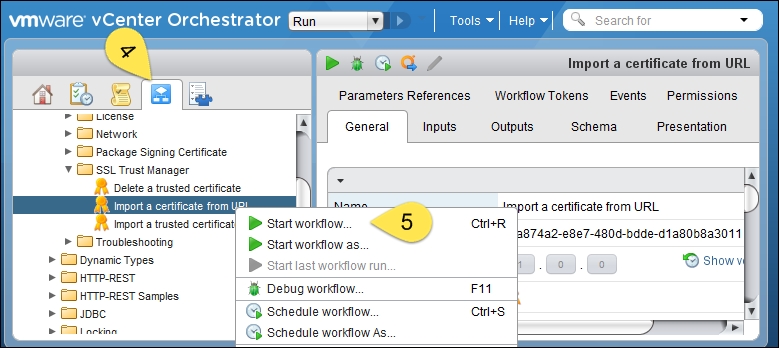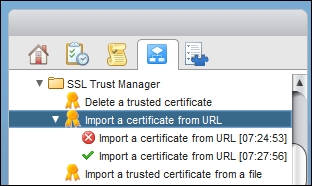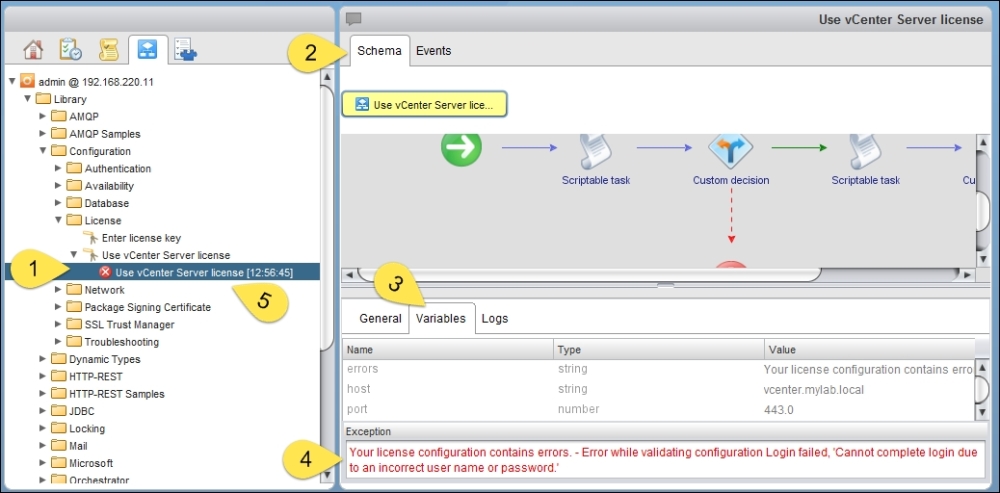In this recipe, we will learn how to access the Orchestrator configuration. There are two ways, both of which work; however, the future is in workflows.
We need an Orchestrator instance up and running, as described in the recipes about installing.
To use the Configuration tool, we just need a web browser; and for the workflow method, we need either a local Java install to start the Java Web Client or an installed Orchestrator Client.
There are two ways to configure Orchestrator; I would encourage you to explore both.
If you are using the Orchestrator appliance, read the Accessing the Orchestrator Configuration tool section of this recipe. If you are using the Windows or vRA-integrated Orchestrator, follow these steps.
Open a web browser and enter
https://[ip OR FQDN of Orchestrator]:8283.In the Orchestrator configuration login screen, enter
vmwareas the username and the password you assigned during the deployment. If you are using the Windows or vRA-integrated installation, the initial password isvmware. As soon as you are logged in, you will be requested to change the password.
The Orchestrator configuration page opens as shown in the following screenshot:

Here are all the sections that can be used to configure Orchestrator.
Access the Orchestrator Client, open a web browser, and navigate to the Orchestrator home page
http://[ip of the vCO VM]:8281/vco/and click on Start Orchestrator Client.Enter your credentials, which are
vcoadminwith the passwordvcoadmin(except for the vCenter-installed Orchestrator version where you have to use the user account[email protected]).You might need to accept the SSL certificate. Click on Install this Certificate… to not have this come up again and then click on Ignore.
Once the Orchestrator Client opens, click on workflows (the blue icon with white in it) and then expand the tree, as seen in the next screenshot.
Here, you'll find all the Orchestrator-specific configuration workflow. Start one by right-clicking on it and choosing Start workflow.

After entering the required information and clicking on Submit, the workflow will start.
A green tick next to the workflow execution will show you that the workflow was executed without an error. A red cross shows that the workflow encountered an error and has stopped. See the How it works... section of this recipe.

The Orchestrator Configuration tool is an independent service in Windows as in Linux. The service doesn't require to be switched on all the time; it is more or less a one-off tool to get the initial deployment working.
The Orchestrator Configuration tool was commonly used to configure Orchestrator, and you will find countless websites still quoting it. It is a generally straightforward tool that helps you configure Orchestrator. The trick is to work your way down, starting with the General section. Every time you configure an item correctly, the little light next to the section title will switch to green. The light turns red if the item is not configured or is misconfigured. When you log in to Orchestrator for the first time, you will notice that all the lights are green; this is because it uses the preconfigured settings. You can still reconfigure all items to your own specifications.
VMware announced that the Configuration tool will be removed in future releases. From then on, the workflow method will be the way to do it. However, currently there is no workflow to import and configure plugins, so this still has to be done using the Orchestrator Configuration tool. The Configuration tool also gives a lot more options for most configuration items than the workflows. In addition, there is also no workflow for exporting or importing the Orchestrator configuration for backup (see the Backup and recovery recipe in Chapter 2, Optimizing Orchestrator Configuration).
It will be interesting to see how the final version of VMware's vision for configuration pans out.
If the workflow doesn't run successfully, you probably will want to know why and resolve the error. To do so, follow these steps:
Click on the failed workflow execution. It has a red icon with a white X in it.
Click on Schema.
Click on Variables.
The error message is displayed in red.
To start the workflow again, just right-click on the failed execution and select Run Again.

This will start the workflow again; however, it preserves all the information you have entered already into the workflow. No retyping is needed as everything from the last run is still displayed in the forms. The only exceptions are passwords, which is a good thing.
There is actually a third way of configuring Orchestrator. Using the REST API of Orchestrator, you can connect to Orchestrator Server and run the configuration workflows. Showcasing this is beyond the scope of this book; however, you can find some instruction in the Orchestrator documentation and also in the Accessing the Orchestrator API via REST recipe in Chapter 6, Advanced Operations.



